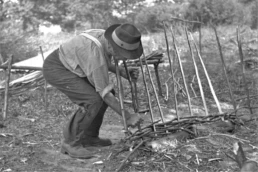The ancient woodlands of the UK, shaped by centuries of management, offer a remarkable template for contemporary sustainable design practices. Traditional methods such as coppicing provide insight into how people once worked harmoniously with nature. These time-tested practices, when examined alongside modern design thinking, inspire a return to sustainability rooted in both material stewardship and emotional durability. This article delves into the history of woodland management and explores how these ancient principles can inform ethical and sustainable design for the future.
A Brief History of Early Woodland Management in the UK
Following the last Ice Age, the once barren British landscape transformed into the lush woodlands we recognize today, populated by species such as oak, elm, birch, hazel, and lime (Taylor, 1982). However, human intervention, particularly from the early Neolithic period (4000–2400 BC), led to widespread deforestation to accommodate the growing need for agricultural land. According to environmental historian Oliver Rackham, roughly half of England had ceased to be wildwood by 500 BC due to early deforestation efforts.
“From Neolithic times onwards, parts of the wildwood, instead of being grubbed out, were evidently turned into managed woodland.” – Oliver Rackham (2001, p. 38)
Despite this large-scale deforestation, early communities developed a sustainable system of woodland management known as coppicing. Instead of simply clearing forests, they discovered that trees, when cut down to the stump, would regrow shoots that were far more useful than the original trunks. This practice not only allowed for the regeneration of forests but also provided communities with a continuous source of timber, firewood, and materials for construction.

Excavations at Flag Fen show ancient use of coppiced woods
The Ancient Art of Coppicing
Coppicing is an age-old forestry technique that involves cutting trees down to their stumps and allowing them to regrow over a set period. This cyclical process enables forests to regenerate while providing communities with a sustainable, renewable supply of wood. The practice allowed early Neolithic people to use wood more efficiently, avoiding the impracticalities of transporting and processing large, mature logs.
Evidence of early coppicing can be seen at sites like Flag Fen, near Peterborough, where thousands of sharpened wooden poles were discovered as part of a large, prehistoric wooden causeway. These poles were selectively cut from regrown trees, showcasing the early mastery of coppicing techniques (Pryor, 2015).
Coppicing continued to evolve over the centuries and became an integral part of the economy. In the 16th century, the coppice and standards method was introduced, allowing for both timber production and the regular harvesting of smaller coppiced shoots. This system ensured forests remained productive for generations, striking a balance between sustainability and economic necessity.
Coppicing and Traditional British Crafts
Coppicing was not just a practice of forestry but also an essential part of British craftsmanship. Hurdle-making, for example, involved weaving coppiced hazel wood into strong, flexible fences that were widely used across the British countryside. In the 1960s, craftspeople like those in Verwood, Dorset (Reeks, 1968), were still practising this traditional skill, passing it down through generations.
These age-old crafts played a crucial role in rural life. In addition to hurdles, coppiced wood was used to make everything from baskets to furniture, road fences to fuel for heating and cooking. The system was designed to sustain local communities, creating objects that were both useful and long-lasting.

Hurdle making in Radnorshire. Image courtesy of the Watkins Collection
The Decline of Woodland Management and Its Consequences
The First and Second World Wars had a devastating effect on British woodlands. The enormous demand for timber during wartime nearly stripped the country of its ancient woodlands. By 1945, much of Britain’s woodlands had been depleted (Bartlett, 2011). The post-war effort to rebuild saw the government favour rapid replanting programs, introducing fast-growing species like Sitka spruce and Douglas fir to meet the urgent demand for timber. However, these monocultures lacked biodiversity, diminishing the ecological value of Britain’s woodlands.
“The Woodland Trust estimates that nearly 50% of ancient woodlands that survived into the 1930s was lost during this period.” – Woodland Trust and Tickell (2000)
Today, Britain remains one of the least wooded countries in Europe, with the National Statistics Office reporting that the UK is the second-largest net importer of forest products, behind only China.
Designing for Sustainability: The Role of Emotional Durability
In the context of today’s environmental crisis, it’s clear that merely focusing on sustainable materials is not enough. Design must also address consumption patterns and foster deeper emotional connections between people and the objects they use. The concept of emotional durability, introduced by Jonathan Chapman in his influential work Emotionally Durable Design, argues for creating products that are designed to last, not only physically but emotionally as well.
“The most common response to being asked how users formed emotional attachments to products was through narrative—a personal history with the product, often related to when, how, and from whom the object was acquired.” – Jonathan Chapman (2009, p. 33)
Objects crafted from responsibly sourced wood, particularly from sustainable practices like coppicing, carry with them a narrative rooted in history and environmental stewardship. These materials tell the story of a time-honoured relationship between humans and nature, one based on mutual benefit and respect.
A Plurality of Sustainable Solutions
“We are not looking for mass answers, but instead a mass of answers.” – Kate Fletcher (Chapman & Gant, 2007)
As Kate Fletcher writes, sustainable design cannot be a one-size-fits-all solution. Rather, it requires a variety of approaches that consider different materials, environments, and cultures.
In today’s design world, incorporating the lessons from ancient woodland management techniques like coppicing offers more than just eco-friendly benefits—it reconnects us with the past and fosters a deeper respect for the materials we use. Designing with these principles in mind helps us address both the environmental and ethical dimensions of sustainability, providing a framework for a more responsible, long-term approach to design and consumption.
Conclusion: Learning from the Past for a Sustainable Future
The history of woodland management in the UK, particularly the practice of coppicing, provides valuable insights into how we can design sustainably in the modern world. By combining ancient techniques with the concept of emotional durability, designers can create products that not only minimise environmental impact but also foster long-term emotional connections with users. This approach challenges the cycle of throwaway culture, encouraging a more thoughtful relationship with the objects we own.
At Foris Studio, we believe in the power of design to make a positive impact. By embracing sustainable materials, respecting traditional craftsmanship, and fostering emotional durability in our products, we strive to create timeless, meaningful designs that are as good for the planet as they are for the people who use them.